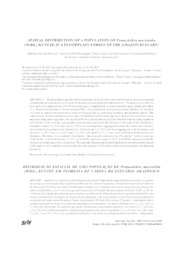Spatial distribution of a population of Pentaclethra macroloba (Willd.) Kuntze in a floodplain forest of the Amazon Estuary.
Spatial distribution of a population of Pentaclethra macroloba (Willd.) Kuntze in a floodplain forest of the Amazon Estuary.
Author(s): DANTAS, A. R.; MARANGON, L. C.; GUEDES, M. C.; FELICIANO, A. L. P.; LIRA-GUEDES, A. C.
Summary: We analyzed the spatial distribution pattern of Pentaclethra macroloba to assist in the development of management plans and conservation of this species in estuarine floodplain forests. The study was conducted in an area of floodplain forest of 55.94 ha, in Mazagão, Amapá, Brazil. A census was performed and all individuals of ? 30 cm circumference at breast height (CBH), living and dead, were georeferenced. Ripley's K function was used to analyze the spatial distribution of the population, including mortality and diameter classes. The relationships between distance to the edge of inundation and density and basal area of the population were analyzed using linear regression. We recorded 993 live individuals and 22 dead. The distribution of the population was found to vary with the topographic gradient associated with the distance to the edge of the inundation. Diameter classes 1 (? 13.2 cm) and 2 (? 18.6 cm) were spatially aggregated close to the water and randomly distributed far from the water. Classes 3 (? 24.0 cm) and 4 (? 29.5 cm) were aggregated at all distances, and classes 5 (? 34.9 cm), 6 (? 40.3 cm), 7 (? 45.7 cm) and 8 (? 51.2 cm), were randomly distributed at all distances. Mortality was randomly distributed. The population density was 18 trees h-1 with a basal area of 49 m2 h-1, and both density (r2=0.51; p=0.0195) and basal area (r2=0.67; p=0.0039) increased with the distance from the edge of the inundation. We conclude that the spatial distribution and successful establishment of this species in floodplain forest are related to the dynamics of flooding and the resultant impacts on dispersal processes.
Publication year: 2017
Types of publication: Journal article
Unit: Embrapa Amapá
Keywords: Dispersal, Dispersão, Forest trees, Pracaxi, Árvore Florestal
Observation
Some of Embrapa's publications are published as ePub files. To read them, use or download one of the following free software options to your computer or mobile device. Android: Google Play Books; IOS: iBooks; Windows and Linux: Calibre.
Access other publications
Access the Agricultural Research Database (BDPA) to consult Embrapa's full library collection and records.
Visit Embrapa Bookstore to purchase books and other publications sold by Embrapa.

